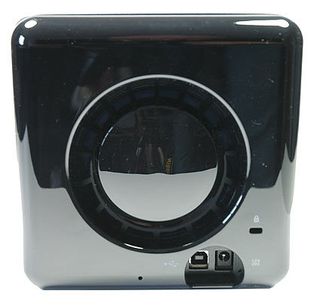Meet Drobo: A Data-Saving Robot
Delivery Content Includes No Hard Drives
A front panel, attached with magnets, catches your eye first. Behind this panel you will find the rickety-looking hard drive bays. You don't need removable frames to equip Drobo with hard drives. Simply slide in any SATA drives into the device. Correspondingly simple is the ejection mechanism: A larger spring next to the SATA interface applies pressure onto the hard drive, which is held by a plastic noose on the other end. It would have been better if there were a front panel with hinges as well as metal nooses instead of plastic ones. Considering the hefty price, this would not have been too much to ask.
Though everything is manufactured solidly, you don't really dare to push against the plastic when ejecting hard drives. Metal rails at each side of the hard drive to help slide it into the bay would have been better. However, the device should be easy to use - and that definitely is the case here.

Using metal instead of plastic and adding a hinge would have helped. You get a good look at the status lights on the bottom and right side.
Connection And Set-Up
Drobo only comes with a USB 2.0 interface. In our opinion, an up-to-date device should at least offer an eSATA port as well. Today, eSATA becomes the default high-performance external storage connection on many motherboards. A bottleneck already looms ahead, given that USB offers much lower data transfer rates than eSATA does. Drobo would thus not be attractive for power users. Since Drobo is designed for home users and direct connections to your system, you will also have to live without a high-speed network connection.

Poor connection possibilities - USB 2.0 is as much as you get. However, the device is designed as DAS (Direct Attached Storage), and not as NAS (Network Attached Storage).
Drobo will run a self test after it is first connected and activated. As a consequence, the temperature-regulated fan will run full-speed for a short period of time, which makes some noise. While in operation, however, a low humming sound is all you will hear. It is definitely good to know that sufficient performance reserves are available for cooling purposes, so a completely equipped Drobo as well as all existing hard drives will not die from overheating.
Your system will recognize the device immediately after connecting it via USB, and will display it in your device manager as a USB mass storage device. Windows Explorer indicates the device has a storage capacity of 2,048 GB. However, this is the value Drobo always claims to provide, even when the device carries no hard drives at all.
Stay on the Cutting Edge
Join the experts who read Tom's Hardware for the inside track on enthusiast PC tech news — and have for over 25 years. We'll send breaking news and in-depth reviews of CPUs, GPUs, AI, maker hardware and more straight to your inbox.
Current page: Delivery Content Includes No Hard Drives
Prev Page Drobo - A First Date Next Page Not A Lot To Choose From: NTFS And HFS Support-
Thank you for your review. I only want to add that there is a 2nd generation drobo that gives Firewire support. Also, you can buy droboshare to go along with one or two drobo for network access. I would be most interested in reading your thoughts about the different connection abilities and speeds. http://www.drobo.com/Products/Index.htmlReply
Thanks again
Most Popular


